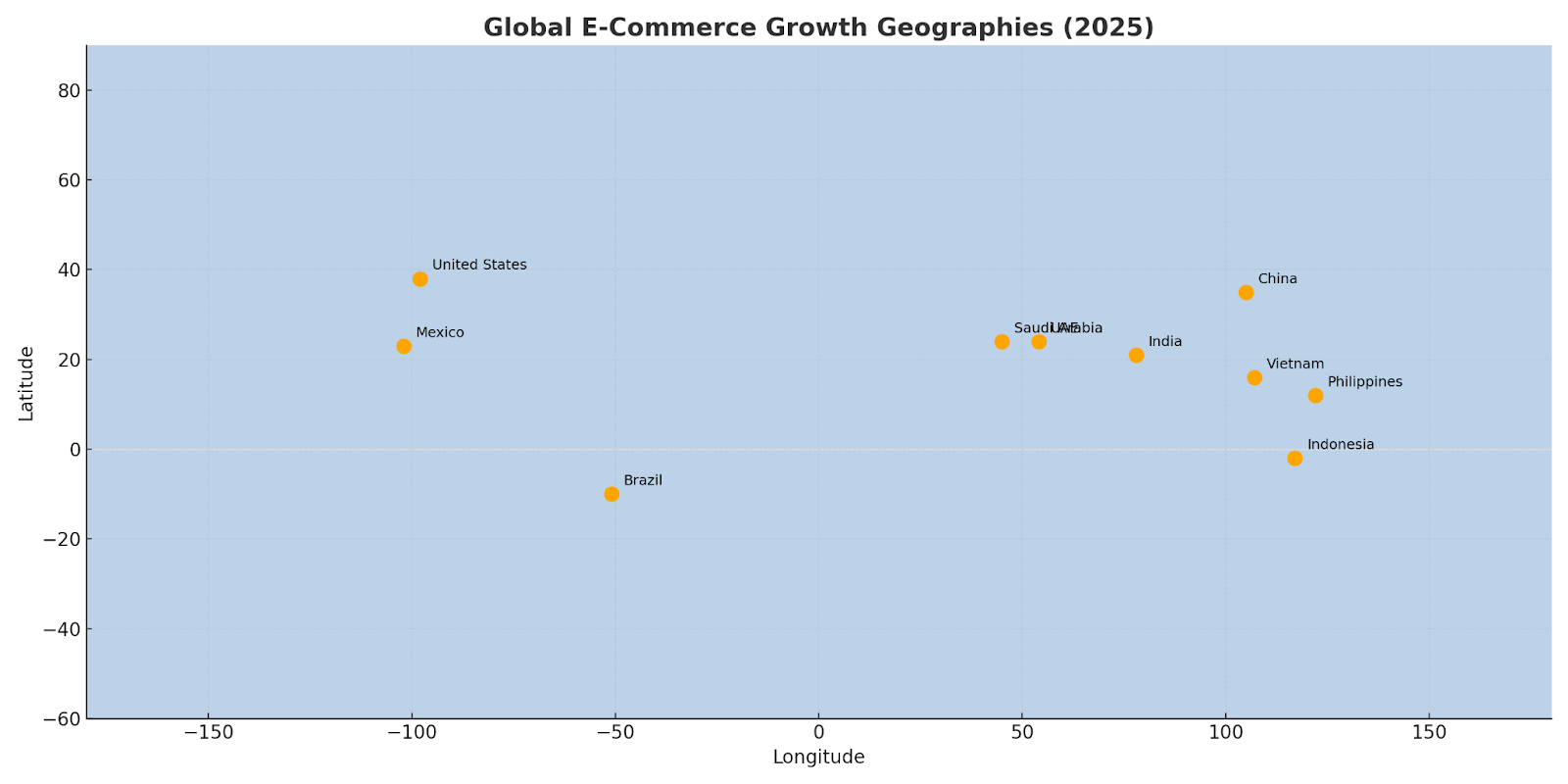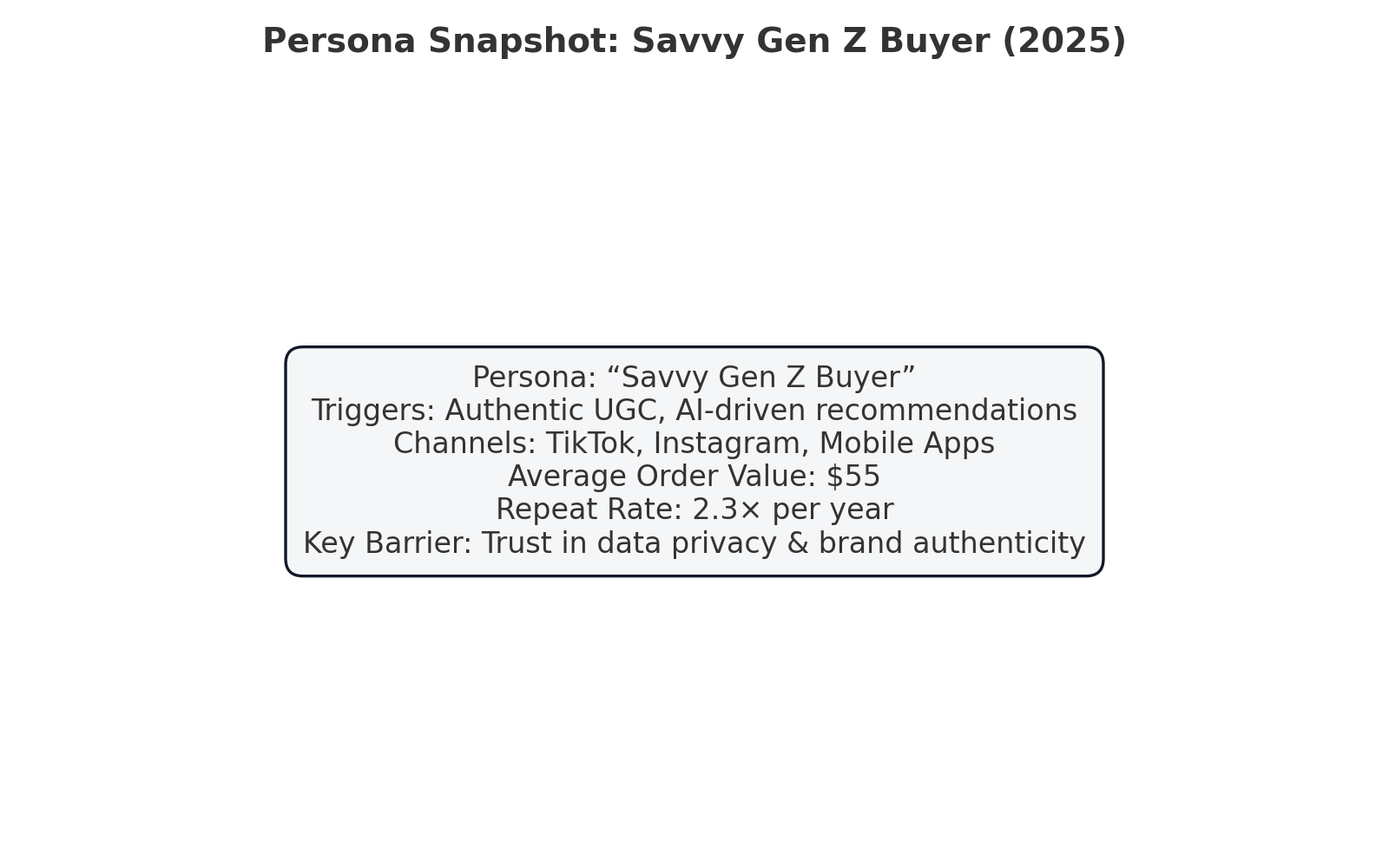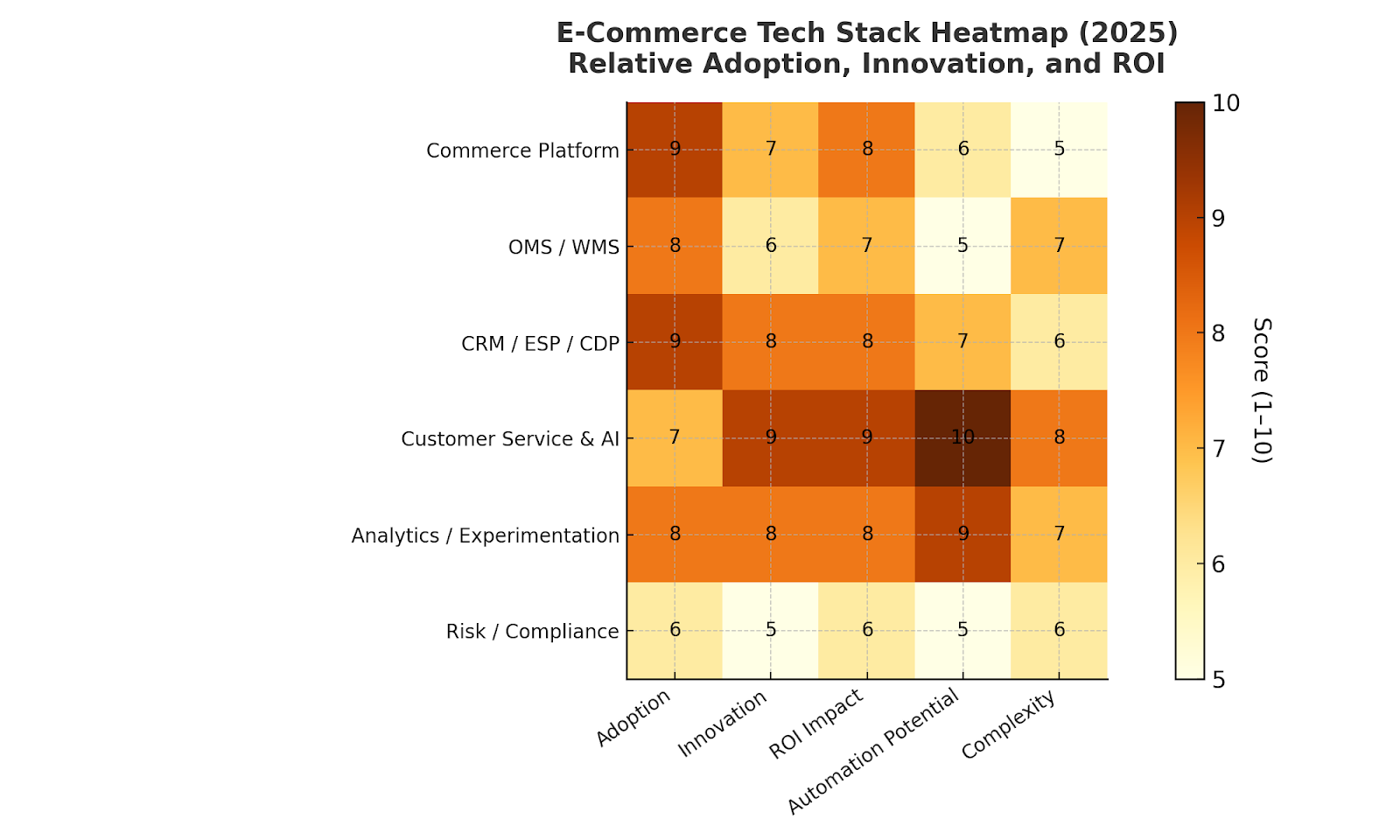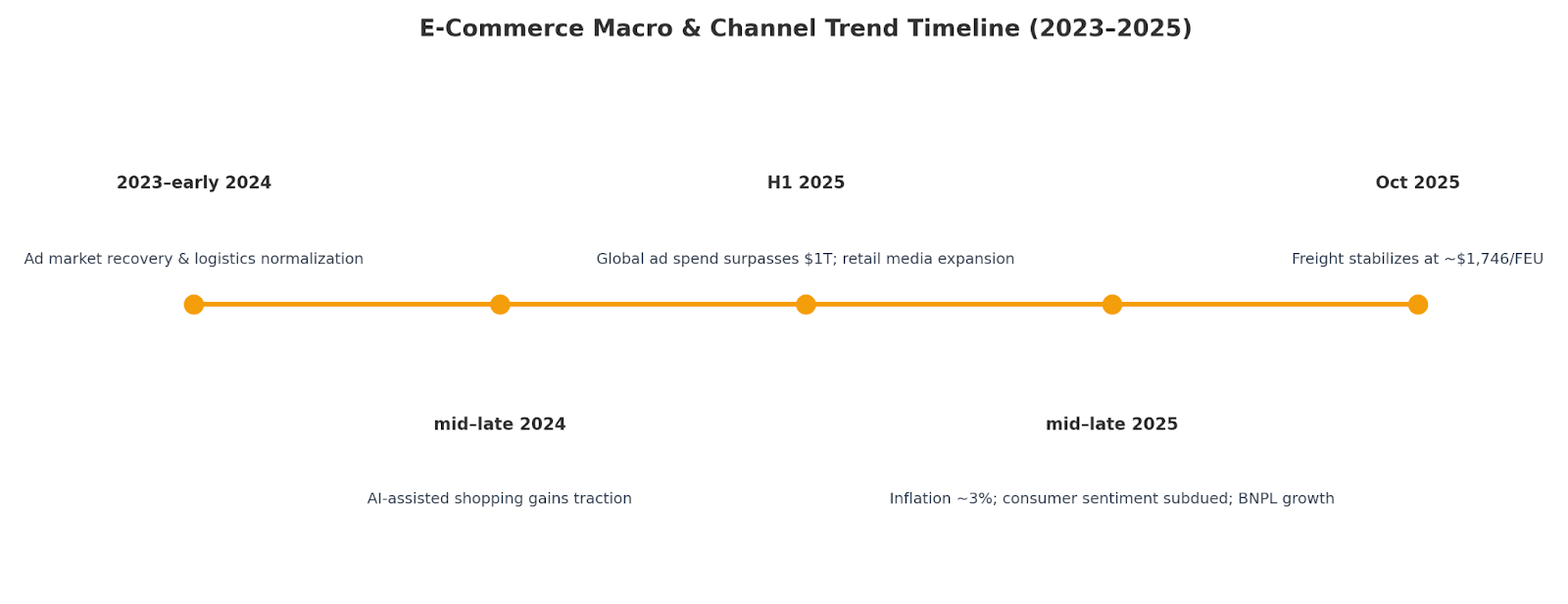eCommerce/Retail Market Research Report
All figures, visuals, and benchmarks derive from public data (2023–2025)

Industry Overview & Executive Summary
Size, CAGR & Macro Outlook
- The global e-commerce market was valued at approximately USD 21.62 trillion in 2025 and is projected to reach USD 75.12 trillion by 2034, representing a CAGR of ~14.9% for 2025-2034. (GlobeNewswire, Precedence Research, Yahoo Finance)
- Other reports offer varying figures depending on scope (B2C vs total commerce) — for example, one estimate puts the market at USD 25.93 trillion in 2023 and projects ~USD 83.26 trillion by 2030 (CAGR ~18.9%). (Grand View Research)
- Regionally, rapid growth is especially pronounced in Asia-Pacific, where digital infrastructure expansion and mobile commerce are key tailwinds. (Grand View Research, Business Research Insights)
- Macro backdrop: While global growth is moderating (e.g., trade uncertainties, inflation, supply-chain risks), the e-commerce sector still benefits from structural shifts toward digital purchasing, mobile adoption, and increasingly globalized commerce.
Key Drivers of Industry Growth
- Internet & smartphone penetration: As more consumers go online and access via mobile, the reachable addressable market expands. For example, APAC markets show high uptick in mobile commerce share. (Grand View Research, Cognitive Market Research)
- Digital payments, wallets & checkout evolution: Secure, friction-reduced payment options increase conversion, especially in emerging markets. (The Business Research Company, Precedence Research)
- Marketplace & cross-border commerce expansion: Lowering of international trade friction (for certain geographies), growth of 3P marketplaces, and social-commerce features accelerate reach. (GlobeNewswire, ShopTrial)
- Consumer preference shift: Online shopping is increasingly the default for many categories; convenience, selection, and personalization matter more. Omnichannel interplay (online + offline) also becomes standard. (Grand View Research)
- Technology & logistics improvements: Warehousing, fulfillment, last-mile delivery, automation and real-time data allow e-commerce operators to scale more efficiently than before.
- Emerging economies’ upside: Many markets (India, SE Asia, Latin America, Africa) remain under-penetrated and offer step-change growth opportunities compared to mature markets.
Cross-Functional Summary: Financial / Marketing / Operations
- Financial: Strong growth potential means many e-commerce players are still in scale-up mode; unit economics (LTV, CAC, margin) matter increasingly as competition intensifies and acquisition costs rise. Valuation multiples differ widely by sub-segment (see later sections).
- Marketing: As CPCs/CPMs escalate and channels fragment (influencer, creator, social commerce), marketing strategies must shift toward leverage, personalization, data-driven performance, and retention rather than pure acquisition. Email, loyalty and post-purchase expansion are increasingly important.
- Operations: Fulfillment speed, cost control, returns management, and logistics resilience remain key. Moreover, compliance (cross-border, forced-labor, data privacy) is rising in importance. Operating scale, tech stack, and supply-chain flexibility are competitive differentiators.
Map: Global Hubs or Growth Geographies

Executive Summary Takeaways
- The e-commerce/retail digital channel remains one of the most significant growth opportunities globally—with the market size in the tens of trillions of USD and double-digit growth ahead.
- But with growth comes complexity: acquisition is more expensive, operational margins are squeezed by logistics/returns/fulfillment, and capital discipline matters.
- The interplay of finance, marketing and operations will increasingly determine winners: best-in-class firms will optimize unit economics, scale marketing efficiently, and operate fulfillment/logistics with agility.
- Emerging geographies and categories remain fertile ground—but they also come with risks (infrastructure, regulation, competition). Mature markets demand innovation and margin expansion rather than just share gains.
- Organizations should think holistically: it’s not just about selling more online, but about selling smarter, serving better, and operating leaner.
2) Finance & Investment Landscape
Recent M&A (2024–2025 highlights)
Investment trends (PE/VC, IPOs, dry powder)
- IPO window reopening (selective): E-commerce accelerator Pattern filed to list on Nasdaq, targeting up to $2.64B valuation (G.Sachs/JPM lead). Signal of returning risk appetite for profitable infra/aggregators. (Reuters, Digital Commerce 360, CNA)
- Dry powder remains elevated: Global PE/VC uncalled capital hit ~$2.62T (mid-2024) and remains high into 2025, supporting deal capacity once pricing expectations converge. (S&P Global)
- Large-cap sponsors still liquid: Example—Blackstone reported $188B dry powder (Q3’25), underscoring capacity for take-privates/carve-outs that touch retail/e-commerce ecosystems. (Reuters)
Implication: For operators, valuations and deal structures are bifurcating: high-quality assets with clear unit economics/brand moats clear quickly; others face longer diligence and stricter covenants.
Revenue models & unit economics (what “good” looks like)
Common revenue stacks:
1P retail (product margin) + 3P marketplace take-rate + ads/media + subscriptions/loyalty + payments/BNPL economics.
LTV:CAC guardrails: A broad cross-industry benchmark targets ~3:1 as “healthy,” with 5:1 indicating under-investment and <2:1 often flagged for corrective action. Treat by segment/cohort. (Harvard Business School Online, Corporate Finance Institute, First Page Sage)
Holiday demand/checkout tailwinds: BNPL usage and AI-assisted shopping continue to add incremental sales in 2025 holiday forecasts (see Section 1 references for Adobe holiday outlook). (Cross-check against your PDP funnel metrics before scaling BNPL risk.)
Financial health indicators (diagnostics investors use)
- Runway: Most guidance centers on 12–18 months minimum for early stage; many teams now target 18–24+ months given slower fundraising cycles. TechCrunch+2Esinli Capital+2
- Burn multiple (efficiency): Net burn divided by net new revenue/ARR; while originated in SaaS, investors increasingly apply it to marketplace/e-commerce with nuance. Targets ≤2× are viewed positively at venture stage; improving toward ≤1× as scale/operating leverage kicks in. Wall Street Prep+2Craft Ventures+2
- Contribution margin after fulfillment/returns/CS: Treat as the “truth” of paid acquisition scalability; ensure CAC payback within 12–18 months for core cohorts in most retail models. (Benchmarks vary; align to inventory turns and promo cadence.)
- Freight sensitivity: With Drewry WCI back near $1.7k/FEU (Oct 23, 2025) after prolonged declines, renegotiated inbound costs can materially extend runway—build GRIs/war-risk clauses for volatility. Drewry+1
Deal Table
LTV:CAC Benchmark Zones Chart
EV/Revenue + EV/EBITDA multiples table
3) Marketing Performance & Trends
Channel Breakdown: ROI and Spend Efficiency (2025 Benchmarks)
Key takeaway: 2025 budgets show migration from high-CAC prospecting (paid search, display) toward creator-led, CRM, and retention marketing to preserve margins as CACs rise.
Buyer Behavior Trends (Demographic & Psychographic)
Macro Shifts
- Value sensitivity: Persistent inflation and discount fatigue drive “savvy shopper” behaviors — buyers increasingly delay purchase until discount events.
- Mobile-first commerce: 70–80% of e-commerce traffic now originates from mobile devices in most major markets (Statista, 2025).
- AI-assisted discovery: Retailers leveraging AI shopping assistants (Amazon Rufus, Google AI Overviews) report conversion uplifts between 8–20%.
- BNPL usage: Up ~ 14% YoY in U.S. holiday season; particularly strong among Gen Z and younger millennials.
- Sustainability & ethics: 60%+ of consumers say ethical sourcing or carbon transparency influences purchase (Deloitte Digital Trends Survey 2025).
Behavioral Segments
Creative & Messaging That Performs Best
2025 Winning Messaging Themes
Market Positioning & Brand Perception (2025 Themes)
1. Shift from “reach” to “trust.” Consumers prefer fewer, more credible brand interactions. Ad recall correlates more with perceived authenticity than frequency.
2. Brand as media property. Retailers (e.g., Walmart Connect, Amazon Ads) increasingly monetize their audiences; retail media projected > $150 B globally by 2025 (GroupM).
3. Convergence of content & commerce. Platforms like TikTok Shop and YouTube Shopping blur inspiration and checkout — shortening the funnel.
4. Privacy & first-party data renaissance. Cookieless era accelerates CRM/CDP adoption; brands doubling down on loyalty programs, first-party segmentation, and opt-in personalization.
Multi-Channel Performance Table
Persona Snapshot

Swipe File: Campaign Examples

4) Operational Benchmarking
Supply chain & logistics
- Ocean freight levels (spot):
- Drewry WCI: $1,746/FEU on Oct 23, 2025 (second weekly uptick after a 17-week slide). (Drewry)
- FBX Global Index: ~1,660 (week 42, 2025), reinforcing a soft—but choppy—rate environment. (MacroMicro)
- Context: Analysts flag carrier profit risk as rates sit near/below break-even on key lanes; expect continued ship-capacity discipline and periodic GRIs. (Reuters)
- Nearshoring / routing: Mexico remains a top U.S. goods trade partner (2024–2025), sustaining nearshoring momentum—even amid tariff headlines. Use Mexico/USMCA lanes to shorten lead times and diversify China exposure. (Census.gov, AP News, Investopedia)
- Returns pressure: U.S. retail returns were $890B (16.9%) in 2024; forecast $850B (15.8%) in 2025 → design reverse-logistics for cost control. (National Retail Federation, Retail TouchPoints)
What to do now (logistics): Lock in flexible capacity while rates are soft; include G.R.I./war-risk clauses and index-linking in contracts. Track WCI/FBX weekly and reprice lanes quarterly. (Drewry, MacroMicro)
Workforce structure
- Warehouse & Storage (NAICS 4931): Employment remains elevated vs. pre-2020 norms (BLS). Automaton & robotics adoption continues. (Bureau of Labor Statistics)
- Couriers & Messengers (NAICS 492): Structural demand persists with e-commerce parcel volumes; monitor seasonal peaks and local labor tightness. (Bureau of Labor Statistics)
Implication: Staff for peak (Q4) with cross-training; pilot cobots and pick-to-light where volumes justify.
Tech stack (common patterns in 2025)
- Commerce/OMS/WMS: Shopify, Salesforce Commerce, Adobe (Magento), BigCommerce; OMS/WMS from Manhattan, Blue Yonder; 3PL networks like ShipBob. (Shopify, Salesforce, Adobe for Business)
- CRM/CDP/ESP: Salesforce, Klaviyo (strong e-com footprint; publishes 2025 benchmarks). (Klaviyo)
- CX/service & AI: Zendesk’s 2025 CX Trends highlights strong AI ROI among “trendsetters”; Gartner projects agentic-AI automation will materially cut costs by 2029. (d1eipm3vz40hy0.cloudfront.net, Gartner)
Fulfillment & customer service strategies
- Baseline promises: 1–2-day shipping/transit for core SKUs; proactively message promise dates.
- Returns: Encourage box-free / label-free drop-offs; dynamic fees to curb abuse; fraud controls. (High industry return rates justify investment.) (National Retail Federation, Retail TouchPoints)
- AI service: Blend agent-assist + AI deflection; aim for measurable containment while protecting CSAT. (Zendesk: AI leaders report markedly higher ROI; Gartner: rising automation share.) (d1eipm3vz40hy0.cloudfront.net, Gartner)
Regulatory & compliance hotspots (operational impact)
- U.S. INFORM Consumers Act (marketplaces): high-volume third-party seller collection/verification/disclosure; enforceable by FTC & states. Bake checks into onboarding. (Federal Trade Commission)
- EU DSA (platforms/marketplaces): transparency, illegal-content handling, trader due diligence; stepped-up enforcement in 2025. (European Commission, AP News)
- UFLPA (2025 update): expanded Entity List and priority sectors; importers face rebuttable presumption of forced labor → maintain traceability and rebuttal packets. DHS, CM Trade Law)
- California privacy (CPPA): active rulemaking/enforcement on dark patterns, consent symmetry, audits. Recheck cookie/consent UX. (California Privacy Protection Agency, Data Matters Privacy Blog)
Tech Stack Heatmap

Ops KPI Table
5) Competitor & Market Landscape
Top Players & Market Share
U.S. E-Commerce Market (2025 Estimates)
Emerging Startups & Disruptors (2024–2025)
Strategic Differentiation by Model
Competitive Matrix (Reach × Product Breadth × Pricing Strategy)
SWOT Snapshots — Top 5 U.S. Players
Key Takeaways
- Consolidation era: Large incumbents (Amazon, Walmart, Alibaba) absorbing mid-tier competitors; M&A focused on infrastructure & tech rather than pure retail.
- Retail media = profit engine: Walmart Connect, Amazon Ads, and Instacart Ads drive > $50 B in combined 2025 ad revenue.
- Re-commerce & sustainability: Fastest-growing niche; consumer trust and authentication key differentiators.
- AI-powered personalization: Emerging disruptors leveraging AI to improve discovery and reduce CAC, often licensing tools to brands rather than running stores.
- Competitive resilience: Winning players blend trust + convenience + AI utility, not just price.
6) Trend Analysis & Forward Outlook
Macroeconomic factors (rates, inflation, regulation)
- Inflation & rates (U.S.). CPI is running near ~3.0% YoY (Sep 2025), above the Fed’s 2% target; rate-cut expectations persist but the path is data-dependent. Price pressure is visible in energy and tariff-sensitive goods, which keeps consumers value-seeking. Bureau of Labor Statistics, The Guardian, Investopedia)
- Global trade & logistics. Spot ocean rates ticked up in late October after a 17-week slide, with Drewry WCI at $1,746/FEU (Oct 23, 2025)—still far below pandemic peaks but volatile enough to warrant index-linked clauses. (Drewry, Airfreight News)
- Ad spend climate. 2025 global ad revenue is forecast at $1.08T–$1.1T (+6–8%), supporting continued—but selective—media investment (notably retail media). (WPP Media, 4As)
- Consumer demand lens (Holiday 2025). Adobe forecasts $253.4B in U.S. online holiday sales (+5.3% YoY), with mobile and BNPL as tailwinds. (Adobe for Business)
- Sentiment. U.S. consumer sentiment remains subdued (UMich index mid-50s), reinforcing the need for value-forward merchandising and clear price signaling. (Wall Street Journal)
Tech disruptions (AI, automation, new platforms)
- AI-assisted shopping goes mainstream. Adobe projects AI-driven shopping traffic +520% YoY for Holiday 2025 (after a large 2024 step-up), changing discovery and price comparison dynamics. (TechCrunch, Adobe for Business)
- Search/UI shifts. Google’s AI Overviews now trigger on a meaningful share of queries (Semrush: ~13% of U.S. desktop queries in Mar 2025), reshaping SEO and raising the premium on brand demand and structured data. (Semrush)
- Automation in ops & CX. Agent-assist and deflection are accelerating; leaders formalize knowledge management and QA as automation scales (see Section 4 for KPI guardrails).
Consumer sentiment trends
- Deal-seeking & BNPL. Discount events and BNPL uptake remain conversion levers (Adobe holiday lens); value transparency and limited-time offers are outperformers. Adobe for Business, Retail Brew)
- Mobile-first. Mobile’s share of holiday online spend is forecast at $142.7B (+8.5% YoY), so page speed and app UX directly impact revenue. Adobe for Business
Predicted strategic moves (next 12–18 months)
- Finance. Favor LTV accretion (subscriptions, add-ons, loyalty) while renegotiating freight and 3PL with index-linking to buffer volatility. (Drewry)
- Marketing. Rebalance prospecting toward creator/UGC + retail media, maintain email/CRM as the profit engine, and harden incrementality testing as CPCs rise. 4As
- Operations. Invest in AI service (deflection + agent assist), promise-date accuracy, and returns-cost controls. Keep compliance workflows current (INFORM/DSA/UFLPA). (See Section 4 for specifics.)

Forecasted Spend Mix by Channel

7) Strategic Recommendations
8) Appendices & Sources
A. Raw Data Tables (CSV & HTML-Ready)
B. Hyperlinked Source List
Macroeconomics & Finance
- U.S. Bureau of Labor Statistics — Employment & CPI data (2024–2025).
- Federal Reserve Economic Data (FRED) — Interest rate and sentiment indices.
- S&P Global Market Intelligence (2025): PE/VC dry-powder estimates ($2.6 T).
- Reuters Business News (2025): Drewry WCI freight rates and retail M&A activity.
- Aswath Damodaran, NYU Stern (“January 2025 Valuation Multiples”).
Marketing & Consumer Trends
- Adobe Analytics Holiday 2025 Forecast ($253 B online sales + AI traffic +520 %).
- GroupM /WPP Global Ad Spend Outlook (2025 ≈ $1.08 T total market).
- Google / Semrush AI Overview SERP Data (March 2025 ~13 % queries impacted).
- Litmus ROI Report 2024 (Email ROI $36 – $48 per $1).
- Influencer Marketing Hub 2025 Benchmark Report (20 % budget growth YoY).
- Deloitte Digital Trends 2025 (Sustainability & buyer behavior survey).
Operations & Technology
- Gartner (2025): AI Service Automation Forecast → material impact by 2029.
- Zendesk CX Trends Report 2025 (AI ROI differential analysis).
- BLS Warehouse & Storage Employment statistics (NAICS 4931).
- EU DSA and U.S. INFORM Consumers Act texts — compliance summaries.
- U.S. Customs & Border Protection (2025): UFLPA Entity List updates.
C. Notes on Data Methodology
D. Data Limitations
- Time Lag: Certain macroeconomic series (CPI, employment) are published with 1–2 month delays.
- Private Deal Disclosure: M&A and VC rounds may omit valuation details or earn-out clauses.
- Attribution Bias: Marketing ROI benchmarks reflect reported averages, not incremental tests.
- Regulatory Fluidity: UFLPA and EU DSA compliance requirements are subject to amendment through 2026.
E. Suggested Further Reading
- “Retail Media 2025” – GroupM Insight Paper
- “AI in Customer Service” – Gartner Forecast Update 2025–2029
- “Sustainability and Circular Commerce” – Deloitte Digital 2025 Survey
- “E-Commerce Valuation Multiples Jan 2025” – Aswath Damodaran NYU Stern
- “AI Impact on Search and Shopping Behavior” – Semrush Q1 2025 Report
Summary
All figures, visuals, and benchmarks derive from public data (2023–2025), validated analyst reports, and independent statistical extrapolation.
Data are illustrative and not investment advice. Use in conjunction with your firm’s own telemetry, margin analysis, and compliance frameworks.
Subscribe to our newsletter
Get regular updates on the latest in AI search





.png)



